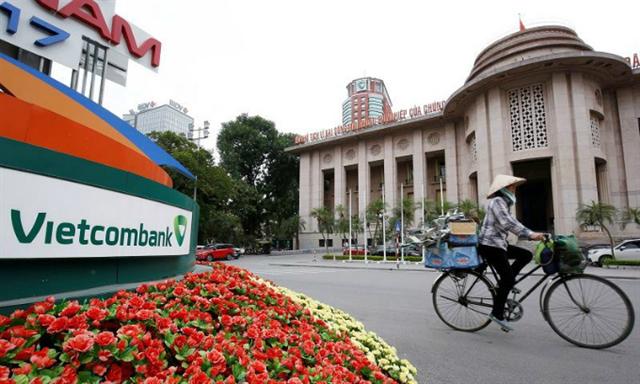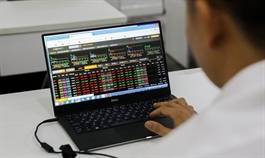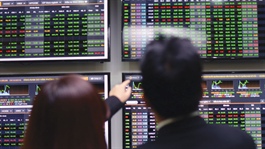2020’s most attractive: which sectors won on the stock market
2020’s most attractive: which sectors won on the stock market
From the time the VN-Index fell due to Covid-19 to its relentless rise starting soon afterward, cash has mostly flowed into banking, steel, real estate, and securities stocks.
A woman rides a bicycle past a logo of Vietcombank, in front of the State Bank of Vietnam building in central Hanoi. Photo by Reuters/Kham.
|
Vietnam’s benchmark index tumbled from 960 points at the beginning of the year to a two-year low of 660 points by March-end when the pandemic first appeared as concerns about a recession and unemployment scared away investors, especially foreign.
But it only made the valuations of many stocks and sectors more attractive, and money began to flow back as investors realized Vietnam was coping well with the pandemic.
Banking
Banking has always been a favorite sector on the Ho Chi Minh Stock Exchange (HoSE). Strong credit growth and economic stability in 2018 and 2019 allowed the biggest banks to record double-digit profit growth, with some, such as state-owned giant Vietcombank, seeing profits hit record levels.
With economic activity and thus demand for capital taking a hit, banks were forecast to do worse this year, but many still reported profit growth in the first half of this year, with 18 out of 19 listed banks targeting average growth of 4.9 percent in pre-tax profit this year as against earlier forecasts that profits would fall 11.9 percent, according to financial data provider FiinGroup.
Many banks explained that they sustained profits due to increased non-interest income and insurance sales, the latter a revenue stream that took off last year when many domestic-foreign bancassurance deals were struck.
However, industry insiders also pointed out that many were reporting good numbers because they have not made full provisions for doubtful debts since the State Bank of Vietnam has allowed them to delay declaring debts related to Covid-19 as bad debts as a measure of support.
Nevertheless, the banking sector drove the VN-Index’s recovery in the second quarter. As of December 22 it was up by nearly 12 percent compared to the beginning of the year, while many bank stocks have surged by over 60 percent.
Many also rose just by listing on the stock market after the government gave banks until the end of this year to do so.
ACB, SHB and VIB were among those to move from the Unlisted Public Company Market (UPCoM) to HoSE this year.
The growth of state-owned banks was less explosive compared to private ones as a result of regulatory constraints on raising their charter capital.
State giants VietinBank, BIDV and Vietcombank, though trading much higher than during their first quarter troughs, only really picked up steam in November.
Securities companies
Stocks of securities firms too only surged in the last two months when trading volumes went through the roof and the VN-Index began nearing the psychological 1,000-point mark, a level it failed to reach in the last two years.
With the market recovering in the final two quarters, profits from both brokerage and proprietary investment are expected to increase. Most leading firms had reported sharp declines in profits or even losses in the first half of the year.
There was a surge in the number of trading accounts opened as other asset classes such as real estate lost their sheen amid the pandemic.
After remaining range-bound at VND16,000 – 18,000 ($0.69-0.78) through the year until mid-October, SSI Securities, the largest broker, saw its share price increase to VND28,650 ($1.23) subsequently.
Other tickers such as HCM of HCMC Securities, VCI of Viet Capital Securities, VND of VNDirect, and BVS of BaoViet Securities hit the ceiling multiple times in the last two months.
Steel
Things began to look up for the steel industry in the second half of the year as the government speeded up disbursement of funds for public construction works and the real estate started to recover as Vietnam brought Covid-19 under control.
In March steel giant Hoa Phat Group was trading at VND13,000 – 14,000, ($0.56-0.60), but recovered to VND20,000 ($0.86) by June-end and has doubled from there to VND40,000 ($1.72) though foreign investors offloaded it.
The dramatic rise was underpinned by HPG’s unexpected third quarter performance when profits doubled year-on-year to VND3.79 trillion ($163.25 million), its highest ever, on rising sales.
HSG of Hoa Sen Group also recovered impressively. The stock started the year at VND12,000 ($0.52), fell way below face value when the market hit bottom at the end of March, but by December 23 was trading at VND22,300 ($0.96).
Like the two leaders, Nam Kim Steel, Pomina Steel and Tien Len Steel have also nearly doubled from their March lows.
Industrial real estate
While not receiving as much attention as the top sectors, industrial zone stocks were also some of the biggest gainers during the year.
Vietnam’s swift Covid-19 response and the trend of companies shifting production from China to Vietnam helped the sector’s growth, especially in the third quarter.
State-owned corporations such as Becamex (BCM), Sonadezi (SNZ) and the Vietnam Rubber Group (GVR) all gained 30-50 percent in August.
Other sectors such as pharmaceuticals, healthcare and real estate were also investor favorites.
During each period cash flowed into a particular bunch of industries.
This, according to analysts, was also a reason for the market’s sustained recovery since it became less dependent on a group of leading stocks, a trend that was quite prevalent before Covid-19.
On December 25 the VN-Index closed at 1,084.42 points, up 12.8 percent from the start of the year, and up 64.5 percent from its nadir in March.




































